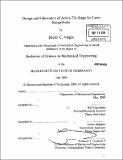Design and fabrication of active tilt-stage for laser rangefinder
Author(s)
Vargas, Héctor C
DownloadFull printable version (7.172Mb)
Other Contributors
Massachusetts Institute of Technology. Dept. of Mechanical Engineering.
Advisor
Karl lagnemma and Genya Ishigami.
Terms of use
Metadata
Show full item recordAbstract
A design for an active tilt-stage that will carry the UTM-30LX, a laser rangefinder sensor (LRF) that is fabricated to scan in a 2-D plane, was determined by analysis. The LRF will be mounted with the tilt-stage on the PIONEER 3-AT (P3-AT), a robot designed to be mobile in rough-terrains, such that autonomous navigation will be made possible. In particular, the purpose of the active tilt-stage is to have the laser rangefinder's scan function expand from 2-D to 3-D by rotating it on the tilt-stage with a servomotor. The main functional requirement for the LRF's new function is for the new 3-D scan to be able to provide good enough resolution such that the failure to detect crucial obstacles that can hinder the movement of the robot is avoided. The analysis was done for worst scenarios in order to determine a good design for the active tilt-stage system that will allow the LRF to perform viably even under these conditions. It turns out that the higher the angular velocity at which the LRF is rotated at by the servomotor is, the worse the resolution becomes. Also, the higher the velocity at which the P3-AT moves, the worse the resolution becomes. The tilt-stage system was designed such that to allow a large potential range of angular velocities that the LRF could be rotated at. Ultimately, this gives the programmer of the LRF/servomotor/P3-AT many options in how the robot should behave under different situations. The main constraints on the physical design of the active-tilt stage are that it should not block the view of the LRF and that a motor that can rotate the LRF at desired angular velocities be selected. Dynamixel's DX-117 motor has been chosen for its sturdiness and for the option to actively control its position and angular velocity. The software portion of the project will be left for a future student who can hopefully find the enclosed analysis useful.
Description
Thesis (S.B.)--Massachusetts Institute of Technology, Dept. of Mechanical Engineering, 2009. Cataloged from PDF version of thesis. Includes bibliographical references (p. 31).
Date issued
2009Department
Massachusetts Institute of Technology. Department of Mechanical EngineeringPublisher
Massachusetts Institute of Technology
Keywords
Mechanical Engineering.